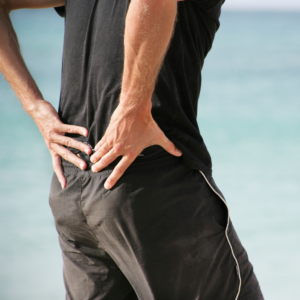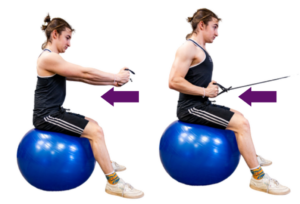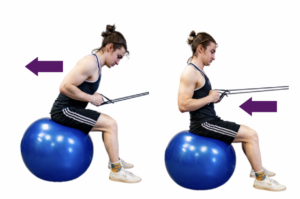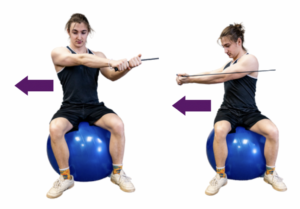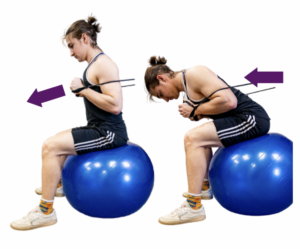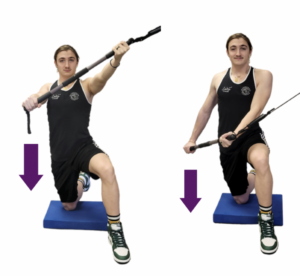Improve core strength with the Best home exercise program – Intermediate Core Exercises
This is the third in our series of exercises you can do at home to recover from a lower back injury, relieve lower back pain, and improve lower back and core strength.
In our first 2 blog posts, we explained the different types of lower back pain, injuries, and conditions that cause lower back pain and sciatica. The exercises we will teach you today are the next step to relieving pain in your lower back and improving your core strength.
Before starting these exercises, you should have completed our beginner series of lower back exercises and core floor exercises and should be able to do 25 reps and 3 sets of each exercise without pain. This is the starting point for people who just injured their lower back or want to strengthen their back from the ground up.
When you can do these exercises proficiently, you will be on your way to living life pain-free and get back to doing things that currently hurt your lower back.
For these exercises, you will need a few pieces of equipment.
You will need an exercise ball, a set of exercise bands or tubing with a wall anchor, and a balance pad. If you want, you can substitute a chair for the ball and a blanket for the balance pad.
As with any exercise program, if you are unsure about your health or ability to do these exercises, check with your physician.
As with our beginner exercise program, start with 2-3 sets of 10-12 repetitions with a band that you can manage and work up to 3 sets of 20-25 repetitions. You can gradually increase the reps by 5 when the number of repetitions is no longer challenging. If you can’t do 3 sets of any of the exercises, start with 1-2 sets. Discontinue any exercise that causes increased pain.
Ball seated row
This exercise will increase the strength of your core and shoulder muscles. It is done on a ball, and you need to attach the band with the band anchor wedged in a closed door, on a wall, or on a doorknob with the door closed. When using a doorknob, loop the band on the doorknob outside the room you are working in, and close the door so the door can’t open, and the band is set. Position the ball about 2-3 feet from where the band is attached and sit up on the ball with good posture. Then pull the bands back while squeezing the muscles between the shoulders.
Ball back extension
This exercise will increase the strength of your lower back extensors and core. Using the same band set up as the ball seated row, sit on the ball and bend forward slightly and pull the bands in as you did in the seated row. Then while keeping your elbows in, extend your body away from the band anchor. Keep your elbows during the whole set as you go backward and return to the starting position.
Ball seated rotation
This exercise will increase the strength of the muscles that rotate your spine and core. Fix a band on an anchor as in the other exercises and sit on the ball facing sideways. You can grip the bands together like you would with a baseball bat. Sit up on the ball with good posture and twist as you pull the band across your body with straight arms. Control the motion as you return to the starting position.
Ball Crunch
This exercise will increase the strength in your core, abdominals, and hip flexors. Sit on the ball as you did in the back extension exercise but facing in the opposite direction. Pull the bands to your chest in the front to tension the bands and keep them there as you flex your body forward. Slowly control the movement as you come back to the starting position.
Half kneeling chop
This exercise will increase the strength in your core as you challenge yourself to maintain the starting position while pulling down and across your body like chopping wood. You will need a stick or dowel to attach to the end of your band and attach the band slightly above shoulder height. This exercise works best with tubing and the door anchor. Start in a half kneeling position and hold the stick or dowel. The band or tubing should be anchored to a door. You can set yourself up with the band to your side or slightly behind you. You should be pulling towards the knee that is down on the ground. As you pull the band across your body, extend the push with the top hand until it is straight.
Do you prefer a video demonstration of these exercises? Click here to access videos and printable demonstrations.
Once you’ve mastered these exercises, you’ll be on your way to having a stronger back and less back pain.
When you can easily perform these exercises for 3 sets, you’re ready for the next level of core exercises found here.
To learn more, sign up for our newsletter, where we share useful tips and information like this!
To download a pdf of this routine, click here.
If you’d like to get out of pain as quickly as possible, you can get an appointment with me by clicking the Request Appointment link on the right-hand side of your screen, or calling (845) 255-1200. I look forward to meeting you.
Affiliate Links to Recommended Products:
Exercise tubing with handles and door anchor 2-20 lbs – https://amzn.to/3Ew1Cfr
Exercise tubing with handles and door anchor 10-50 bs – https://amzn.to/3sMqBUiZ
Balance pad – https://amzn.to/3LrBVwJ
Physioball – https://amzn.to/3CpKHbZ
To see additional recommended items, please visit this link.
To read about other recommended exercises to improve core strength, visit my blog.

